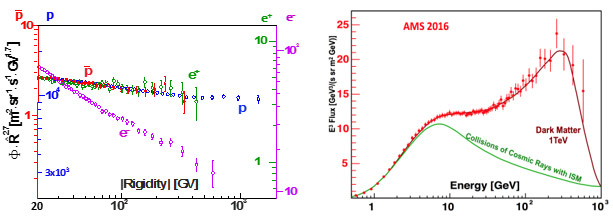Unlocking the Secrets of the Cosmos: The First Five years of AMS on the International Space Station
The Alpha Magnetic Spectrometer (AMS) Collaboration presented the results based on five year observations on the International Space Station (ISS) since May 2011 based on more than 90 billion cosmic rays with up to multi-TeV energies. Four elementary particles – electrons, protons, positrons and antiprotons – can travel through the cosmos and eventually reach AMS. Electrons and positrons have much smaller mass than protons and antiprotons so they lose much more energy in the galactic magnetic field. Surprisingly, at 60-300 GV, positrons, protons and antiprotons display identical momentum dependence, but electrons exhibit a totally different energy dependence [1]. In addition, the positron flux shows a rising from 8 GeV above the rate expected from cosmic ray collisions, the spectrum exhibits a sharp drop off at high energies in agreement with the dark matter model predictions with a mass of ~1 TeV.
The Big Bang origin of the Universe requires that matter and antimatter be equally abundant at the very hot beginning of the universe. The search for the explanation for the absence of antimatter in a complex form is known as Baryogenesis. The observation of a single anti-helium event in cosmic rays is of great importance. In five years, AMS has collected 3.7 billion helium events (charge Z = +2). To date we have observed a few Z = -2 events with mass around 3He. At a rate of approximately one antihelium candidate per year and a required signal (antihelium candidates) to background (helium) rejection of one in a billion, a detailed understanding of the instrument is required. In the coming years, with more data, one of our main efforts is to ascertain the origin of the Z = -2 events.
[1] M. Aguilar et al., Phys. Rev. Lett., 117, 091013 (2016).

Left. The positron, proton, and antiproton spectra have identical rigidity dependence at 60-300 GV. The electron spectrum exhibits a totally different behavior, it decreases much more rapidly with increasing rigidity.
Right. The current AMS positron flux measurement compared with theoretical models.

WebSite: http://www.phys.sinica.edu.tw/files/files20161212_AMSPressRelease.pdf
WebSite: http://www.phys.sinica.edu.tw/files/files20161212_AMSPressRelease.pdf